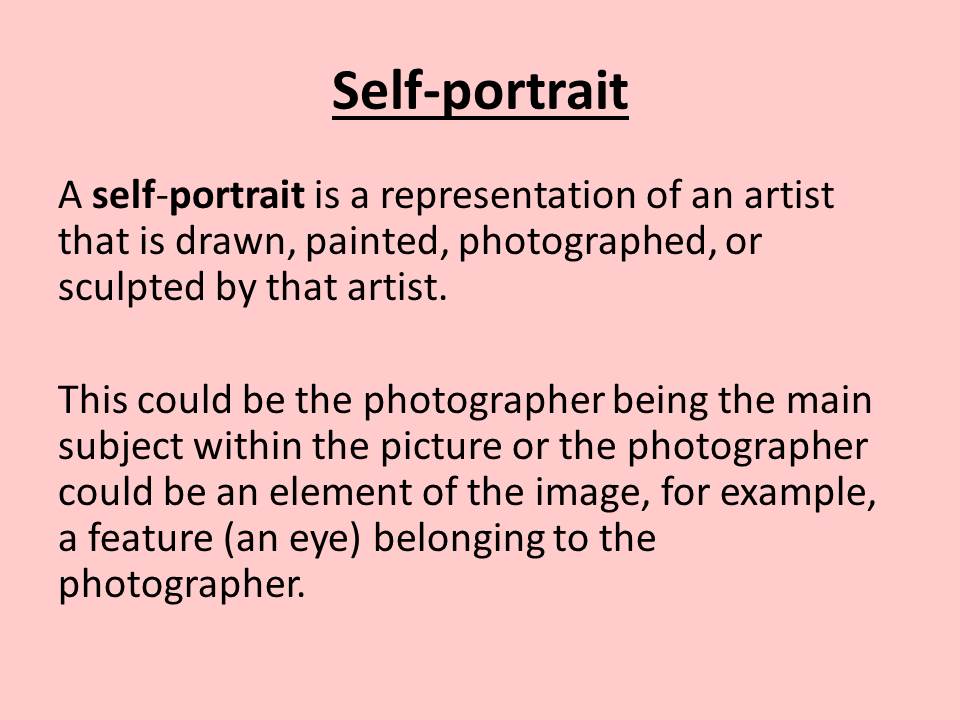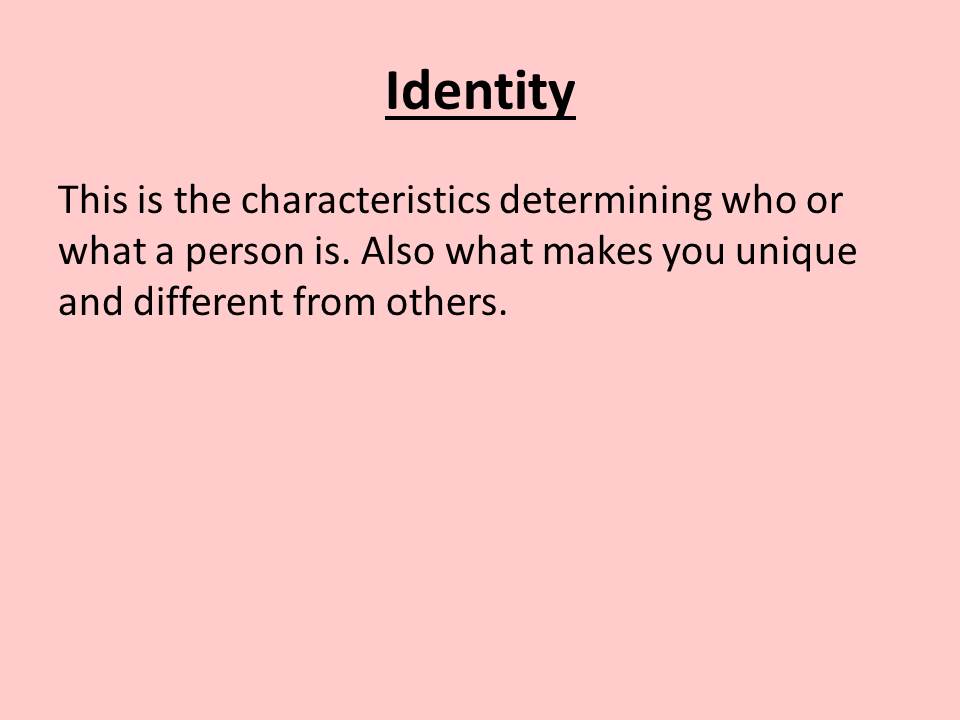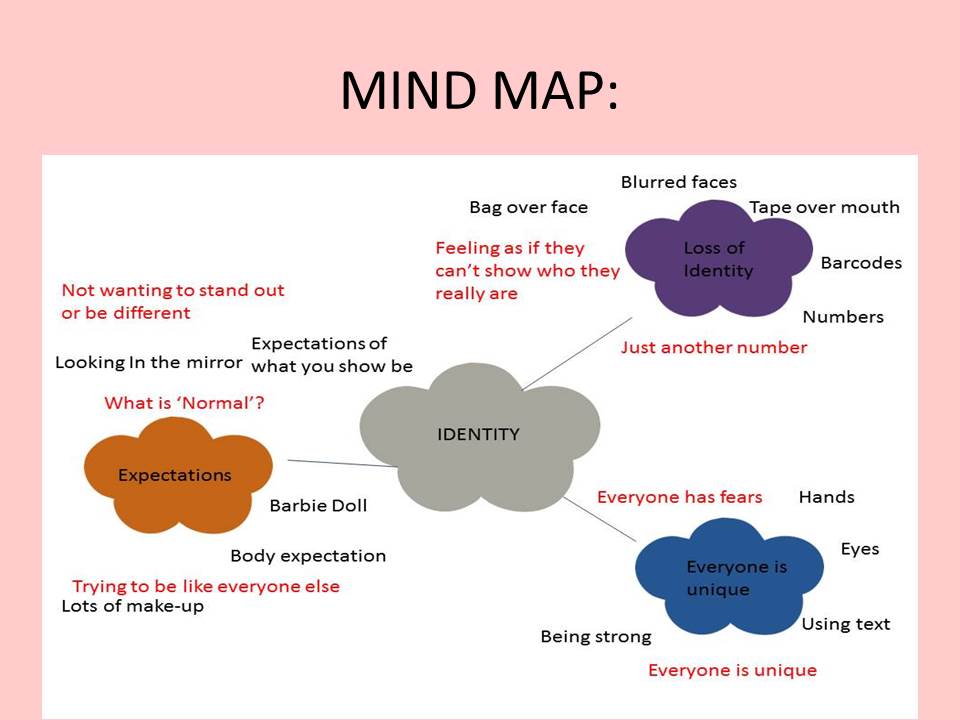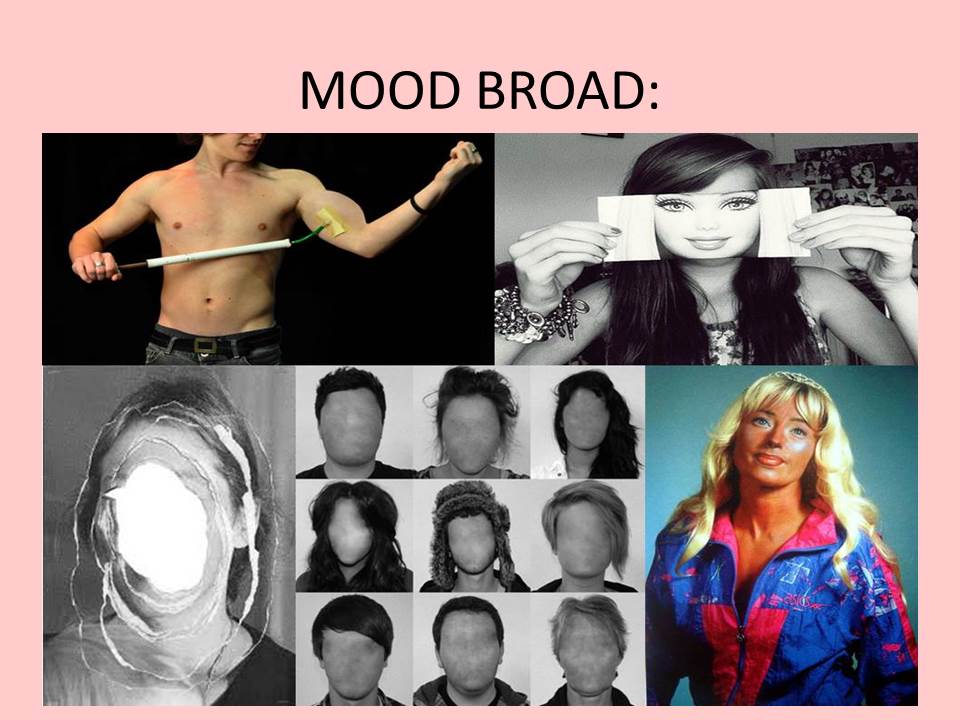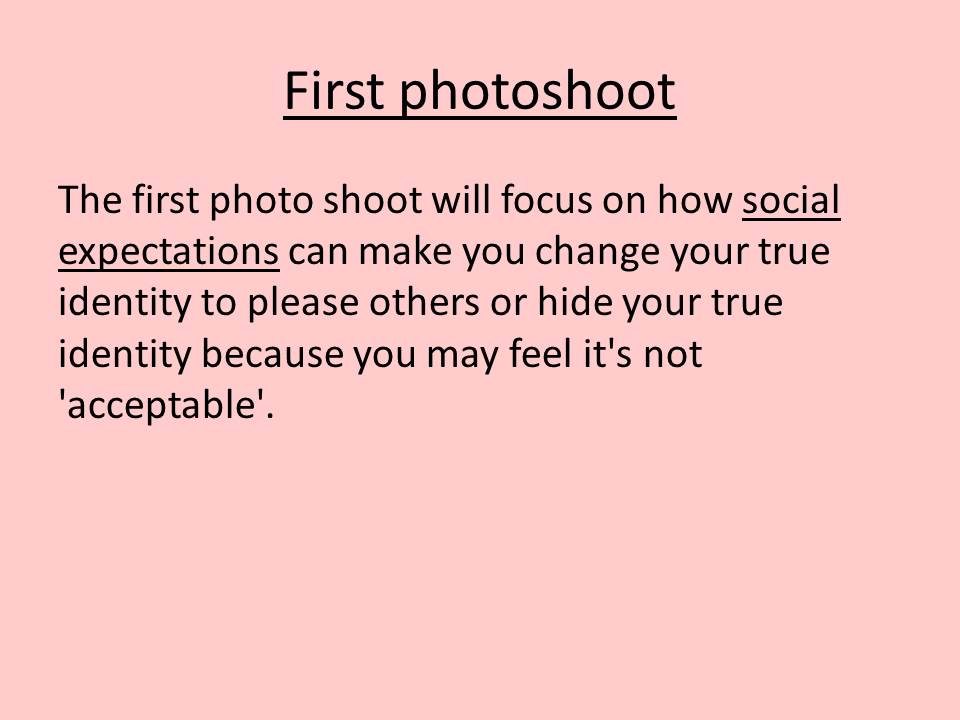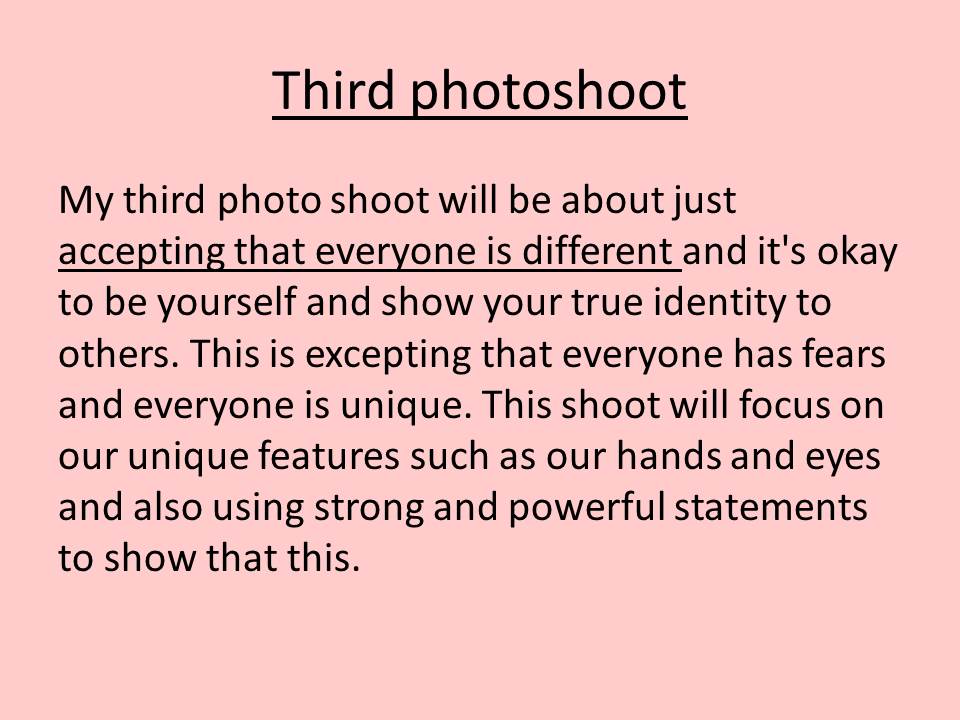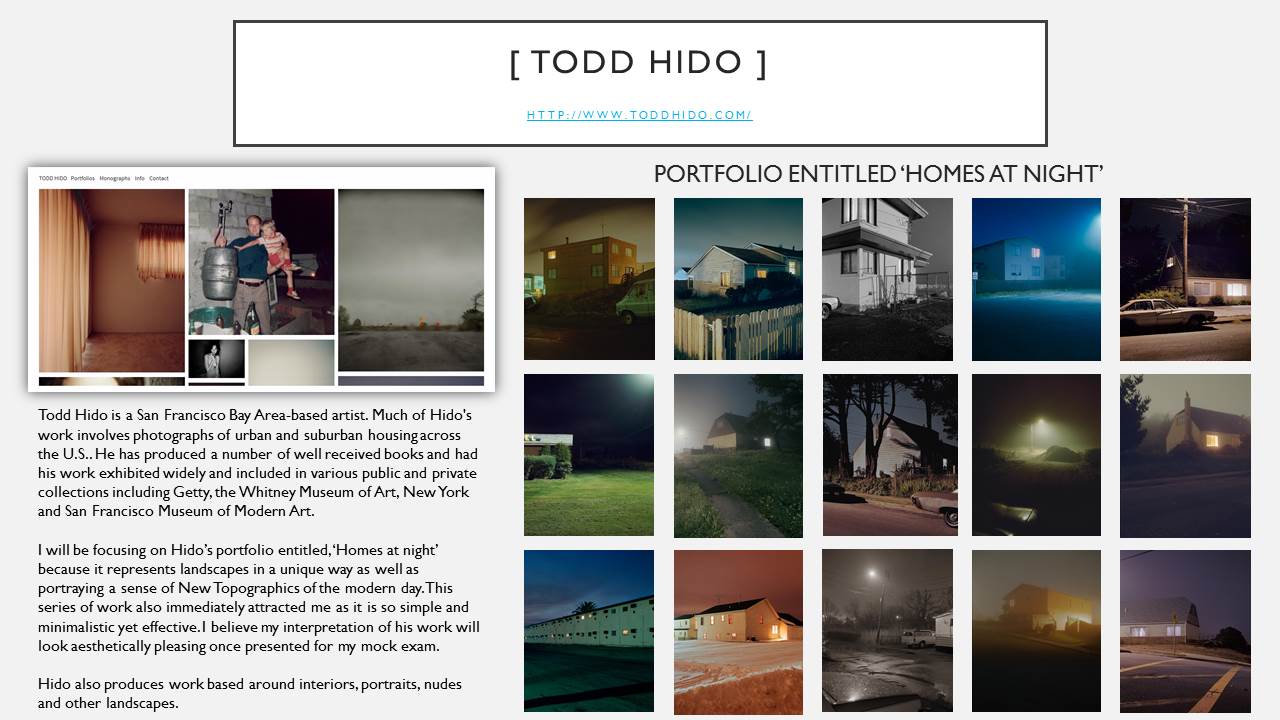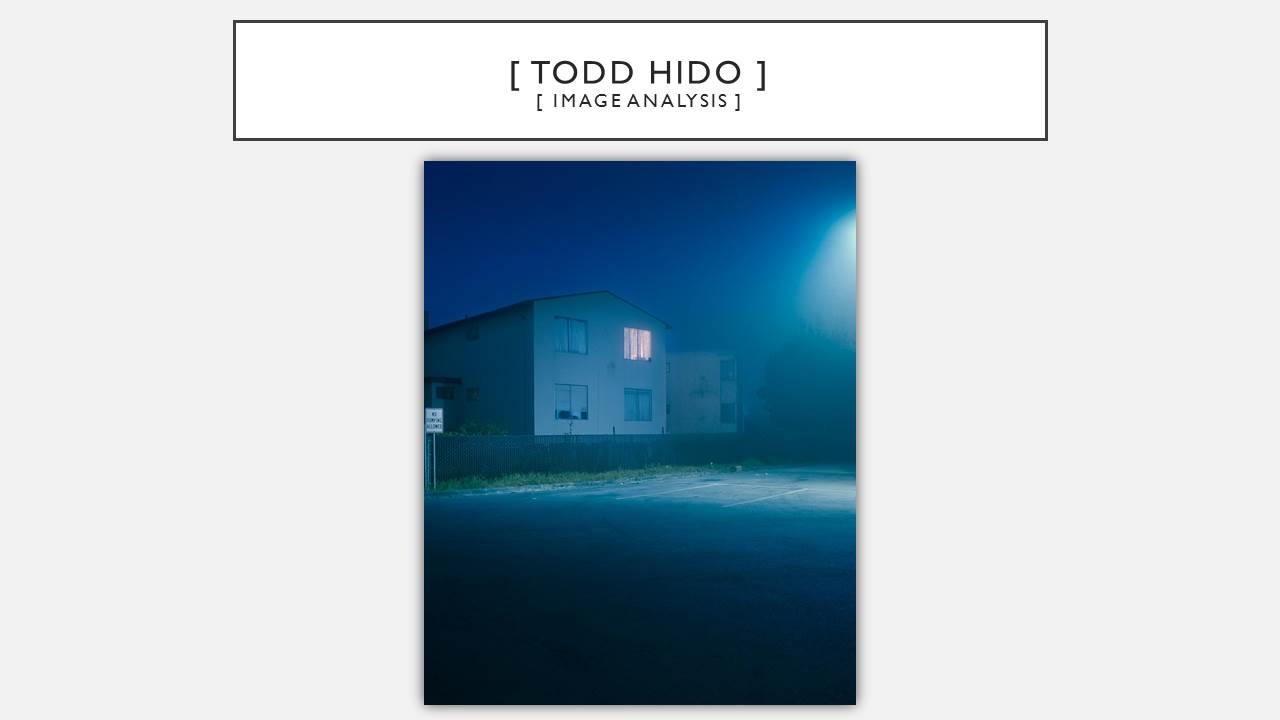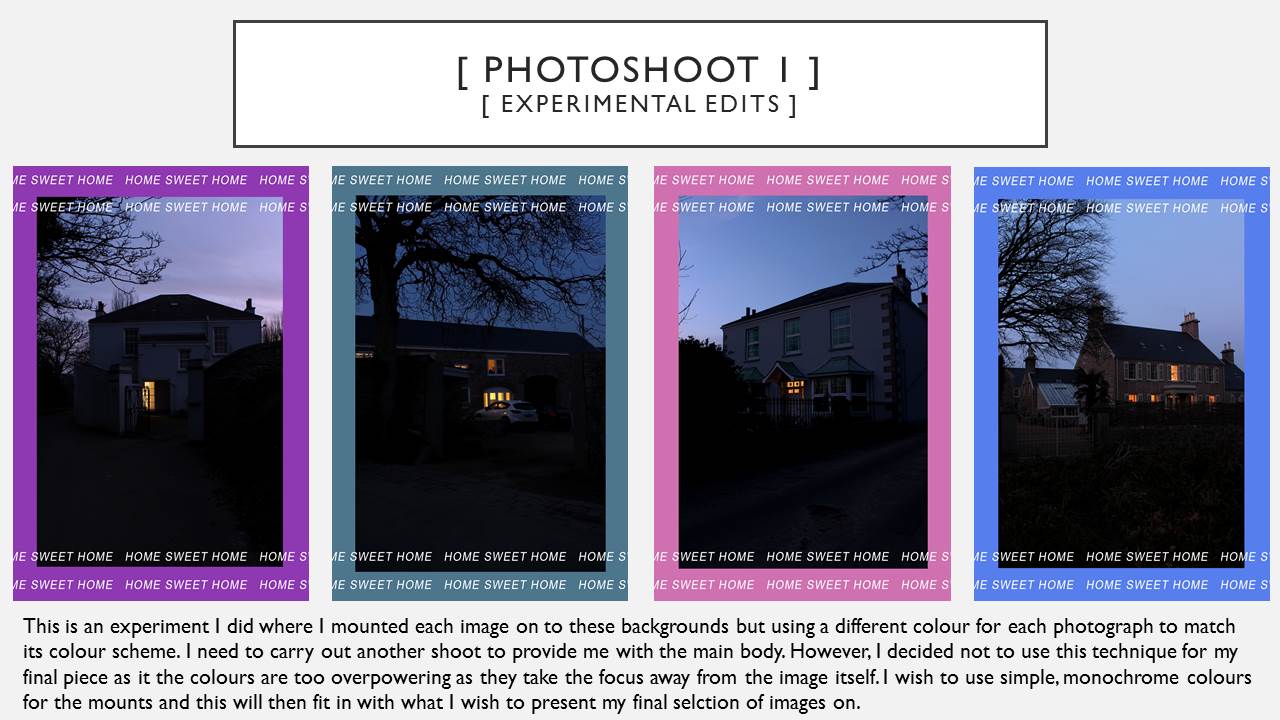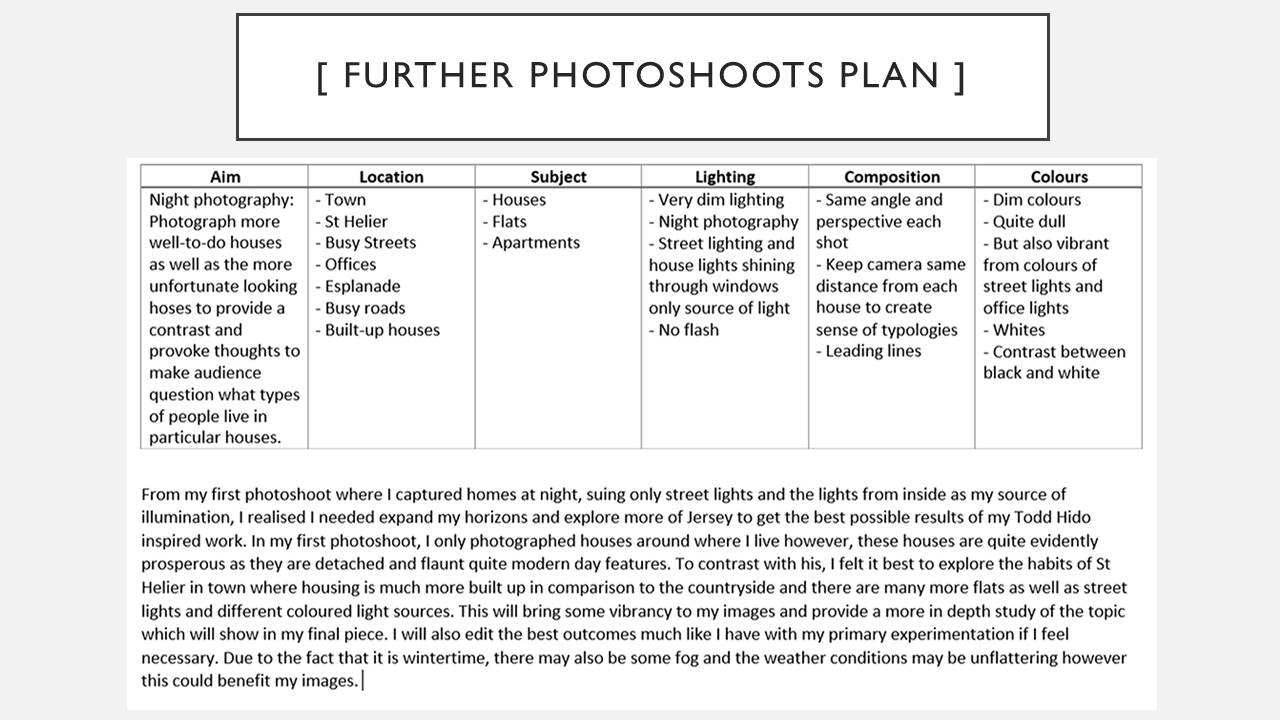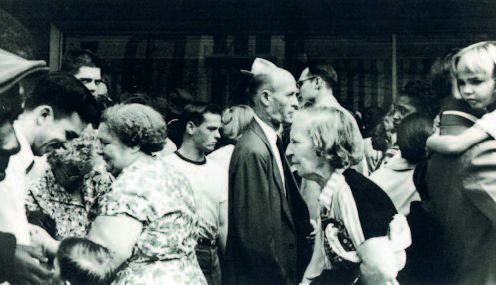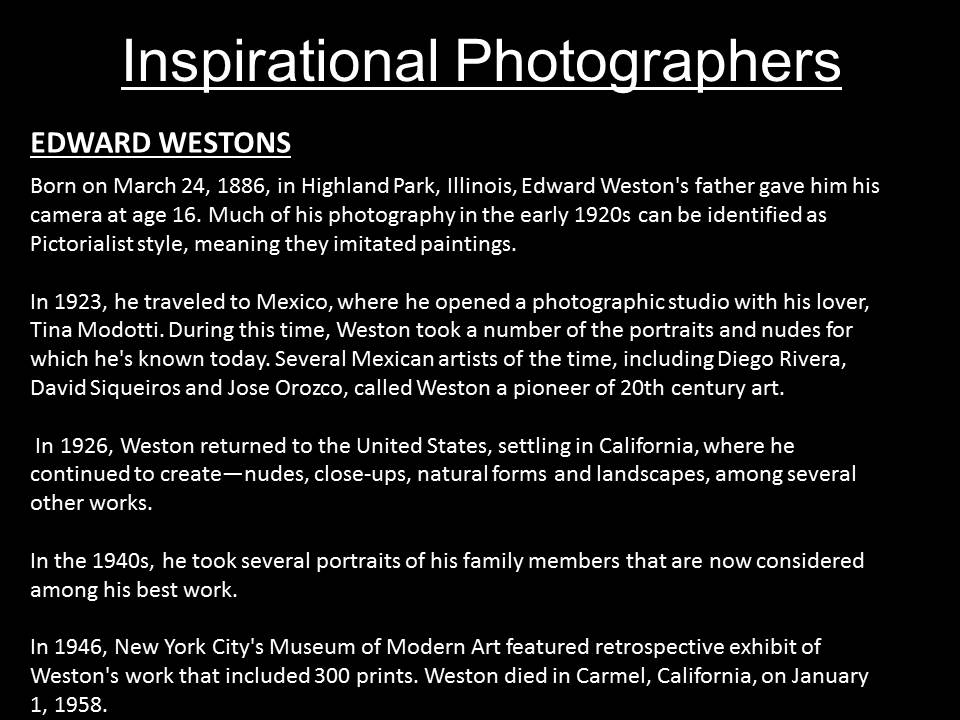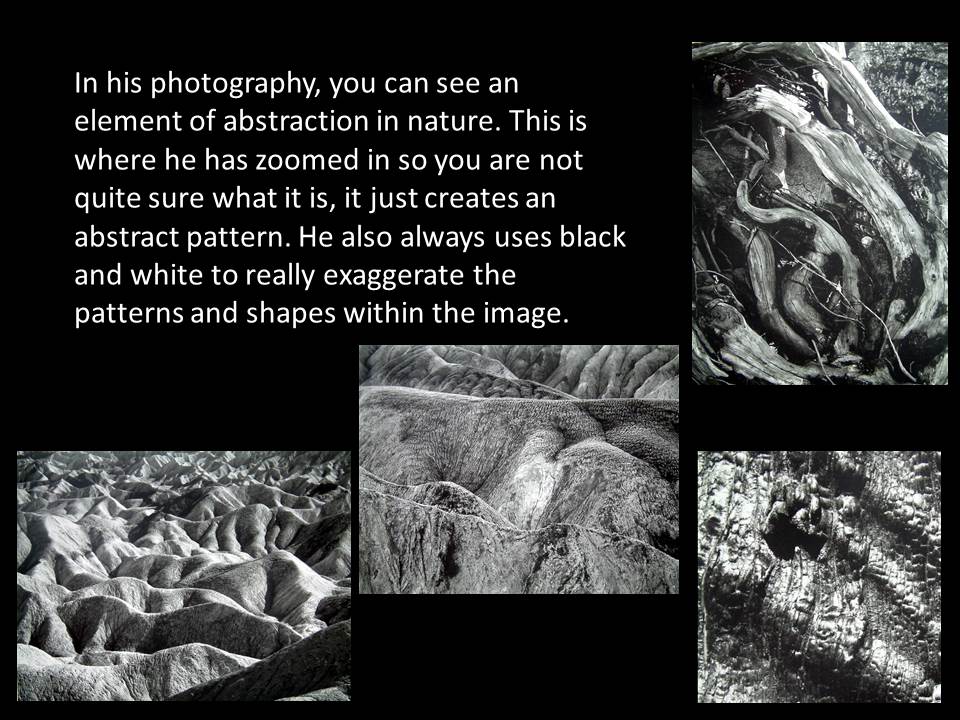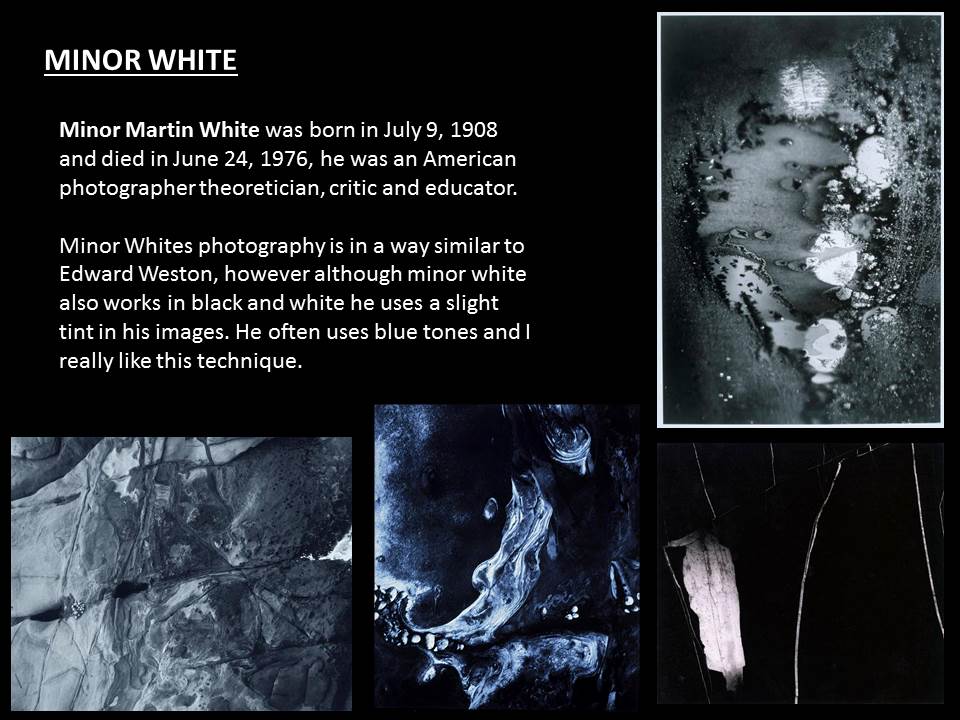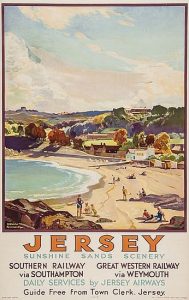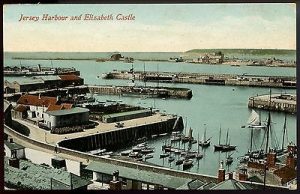Here are some videos of interviews with Todd Hido, my inspiration for the night photograhy series. These have helped me understand his views on the topic and have aided my knowledge of how to take photos to achieve a positive outcome. I also understand why he enjoys taking the images he does and I have tried to embrace this as much I can in my interpretation.
Category Archives: Planning
Filters
Updated Mock Exam Preparation
Photoshoot 2 Plan // Night Photography // Final Piece
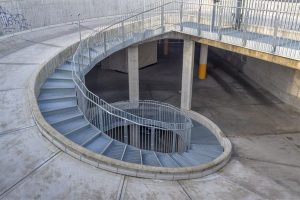
AS Photography Exam Title Guidance : “Structure”
AS Photog Exam: w/c Monday 24th April
- Groups C & D: Monday 24th & Thursday 27th April
- (Wednesday NO EXAM)
- Groups A & E: Tuesday 25th & Friday 28th April
Read this carefully and think how you can design a thorough unit of investigation that explores your chosen theme, topic or subject matter…
-
1.the arrangement of and relations between the parts or elements of something complex.“the two sentences have equivalent structures”
synonyms: construction, form, formation, shape, composition, fabric, anatomy, make-up, constitution; More
-
1.construct or arrange according to a plan; give a pattern or organization to.“services must be structured so as to avoid pitfalls”
<<<CHOOSE 1 STARTING POINT ONLY>>>
Use mindmaps and moodboards to start…
You should aim to complete at least 1 Photo-shoot per week
Structure
- Erin O’Keefe often photographs objects propped up in a corner. Her work explores the visual ambiguities of shadow, space, shape, colour and reflection. Originally an architect, her photographs are of real structures without using digital manipulation such as Photoshop. Many other photographers have experimented with constructed spaces and reflections, such as Florence Henri, Robert Smithson, Owen Kydd, David Haxton, Thomas Demand, Paul Strand etc
Florence Henri
Composition Nature Morte, 1929
photograph
2. Robert Frank shocked his adopted country when he published his groundbreaking book The Americans in 1957. Rather than seeing the cosy Middle America personified in later TV cartoons like The Flintstones, he revealed the raw push and shove of a society that was at odds with itself. Other photographers such as Nan Goldin, Jeff Wall, Chris Killip and Sophie Calle have also been compelled to expose the real structures in society and ‘Tell it like it is’.
Robert Frank
Canal Street – New Orleans, 1955
photograph
3. Stories can be told in a single frame, three frames, or, as in films, millions of frames. Narrative structures can be linear, such as with Duane Michals’ sequences, or non-linear such as Paul Graham’s A Shimmer of Possibility and Wolfgang Tillmans’ If One Thing Matters, Everything Matters. Photographers, filmmakers and animators find unique ways to structure the narratives in their work.
Duane Michals
Alice’s Mirror
photograph
Bill Owens
Untitled from ‘Suburbia’
photograph
4. Photographers have been fascinated by the structure of natural forms from the earliest days of the medium. Karl Blossfeldt found a monumental presence in simple seedheads. Edward Weston revealed beauty in the forms of peppers and shells. Robert
Mapplethorpe, Ori Gersht, Todd McClelland and Olivia Parker have also focused on natural forms in different ways, demonstrating personal responses to light and texture.
RM
Honesty
photograph
Here are some other suggestions that may stimulate your imagination / Starting points for photo-assignments
• Pine cones, pineapples, grapevines, hops, ivy, bindweed
• Scrapyards, building sites, cranes, restoration yards, derelict ruins
• Crystals, molecules, geology, fossils, footprints, tracks
• Stadiums, orchestras, rock concerts, floodlights, staircases
• Motorways, railways, runways, dockyards
• Flowers, plants, trees, fungi, algae, feathers, scales, shells
• Nests of weaver birds, wasps and bees, termite mounds, baskets
• Circuit boards, pipework, telephone poles, towers, pylons, skyscrapers
• Shop displays, escalators, bars, libraries, theatres and cinemas
• Gardens, parks, playgrounds, swimming pools, beaches
• Dolls, mannequins, puppets, cuddly toys, Lego
Assessment Objectives
You should provide evidence that fulfils the four Assessment Objectives:
AO1 Develop ideas through sustained and focused investigations informed by contextual and other sources, demonstrating analytical and critical understanding
AO2 Explore and select appropriate resources, media, materials, techniques and processes, reviewing and refining ideas as work develops
AO3 Record ideas, observations and insights relevant to intentions, reflecting critically on work and progress
AO4 Present a personal and meaningful response that realises intentions and, where appropriate, makes connections between visual and other elements.
Your preparatory studies should show evidence of:
• your development and control of visual literacy and the formal elements (tone,
texture, colour, line, form and structure)
• an exploration of techniques and media
• investigations showing engagement with appropriate primary and
secondary sources
• the development of your thoughts, decisions and ideas based on the theme
• critical review and reflection
Good luck and make sure you ask for guidance at any stage of the process…remember to play to your strengths and approach this unit in a similar way to your coursework units !!!
Abstraction in Nature
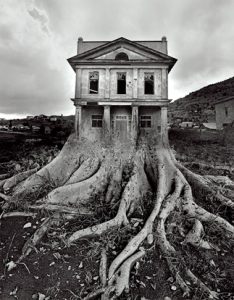
Editing // Experimenting // Presenting your final images
You have until Friday 17th February to finalise your best landscape images. You can choose 3-5 images. Choose wisely…
- you must show a thorough and clear understanding of your influences and inspiration (distinguishing features) (AO1)
- you must show a skillful ability to capture light and correctly / creatively expose your images (AO3)
- you must show a range of editing skills…that are informed by your choice of photographer (AO2)
- you can explore and develop a range of images that illustrate your critical understanding of a particular kind of landscape (AO4)
Your Concept and Context
- to display a higher level of learning and understanding your final blog posts must show an exploration of a theme, a topic or even a title inspired by these sub-genres
- documentary…commenting on a range or type of landscape, exposing the “truth” about the areas we live in etc
- surrealist…composing unreal or imaginary landscapes, possibly dystopian settings
- abstract…an exploration of alternative beauty, capturing light, colour, shape, reflections etc
- romanticised…a celebration of natural rawness, wonder and awe inspired by painting, poetry, drama and music
Possible titles to choose from…
Dereliction / Isolation / Lonely Places / Open Spaces / Close ups / Freedom / Juxtaposition / Old and new / Erosion / Altered Landscapes / Utopia / Dystopia / Wastelands / Barren / Skyscapes / Urban Decay / Former Glories / Habitats / Social Hierarchies / Entrances and Exits / Storage / Car Parks / Looking out and Looking in / Territory / Domain / The Realm / Concealed and Revealed
Tanja Deman and the concept of Collective Narratives
Link here : https://photogrist.com/tanja-deman/
You may want to try a range of experiments inspired by these…
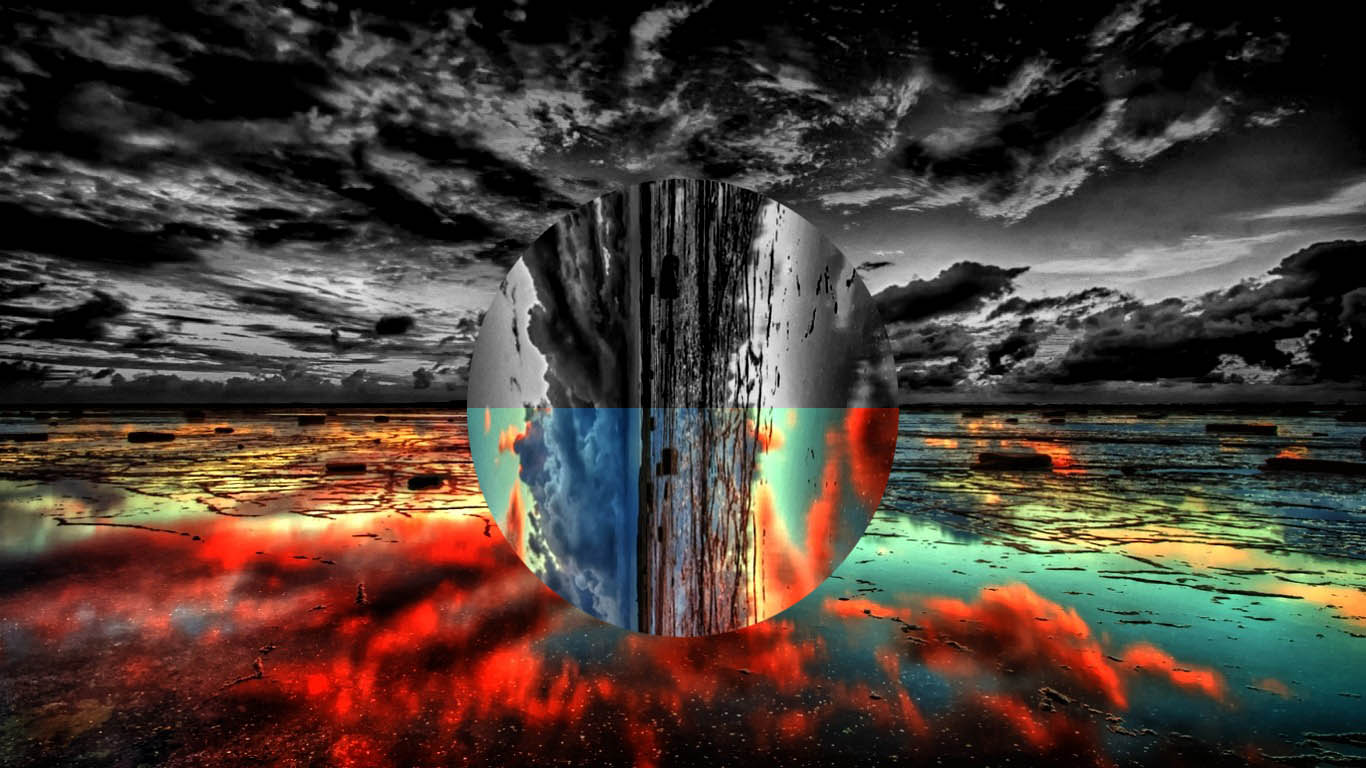
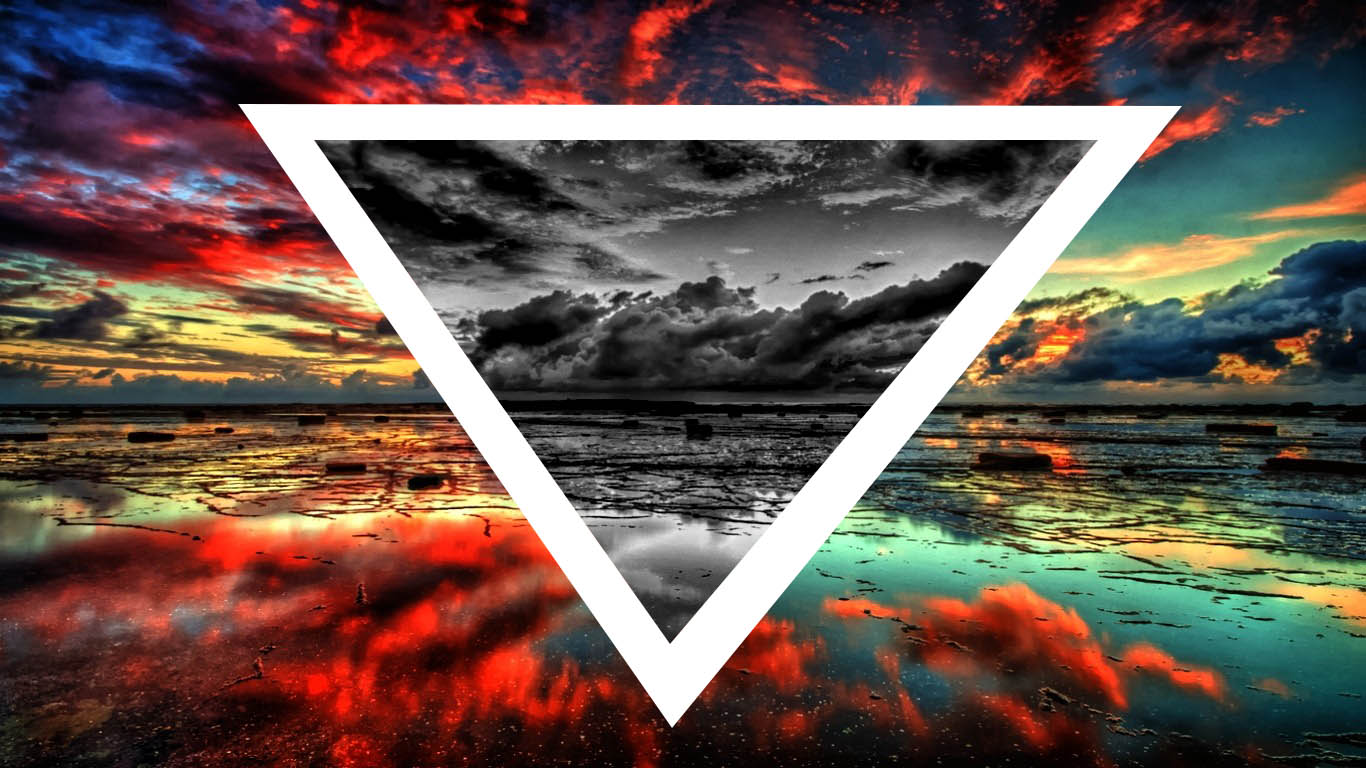
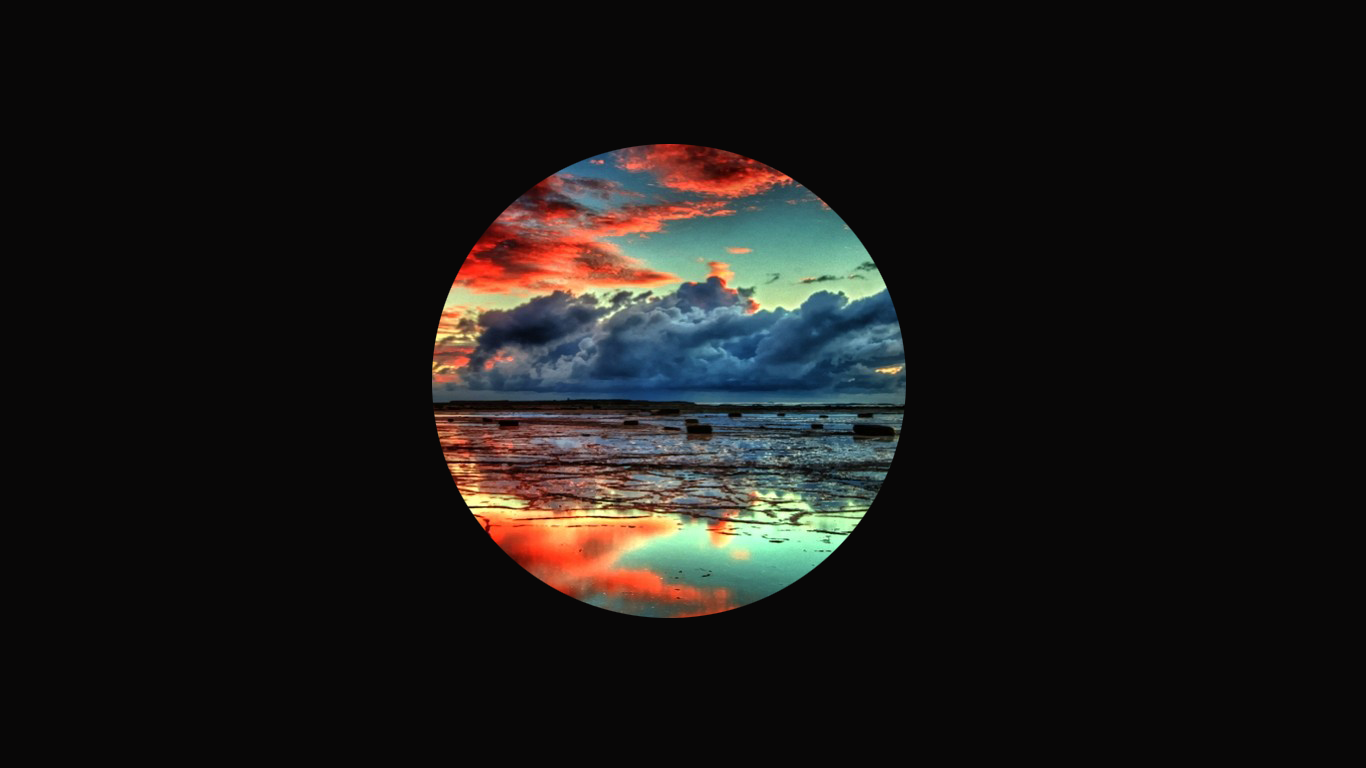
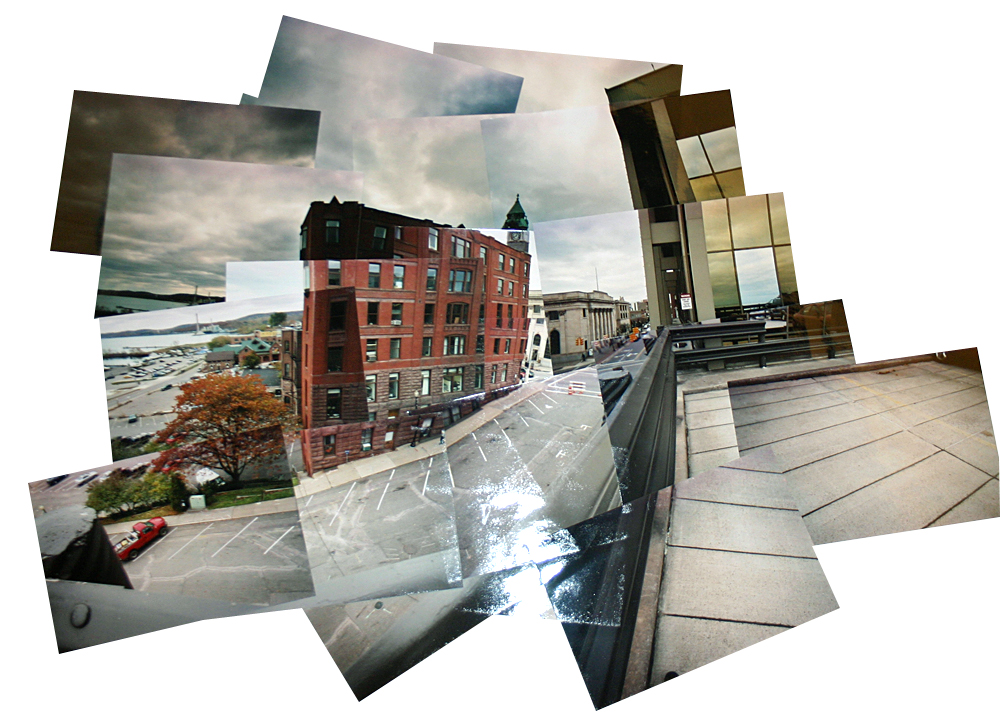
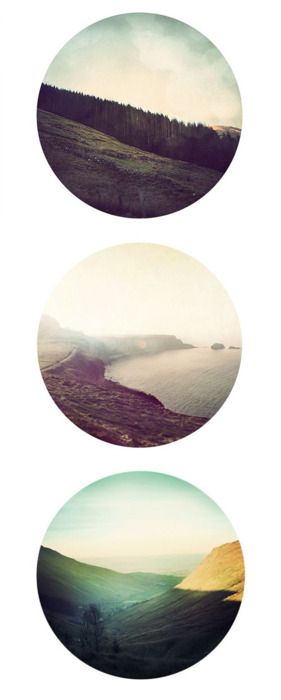
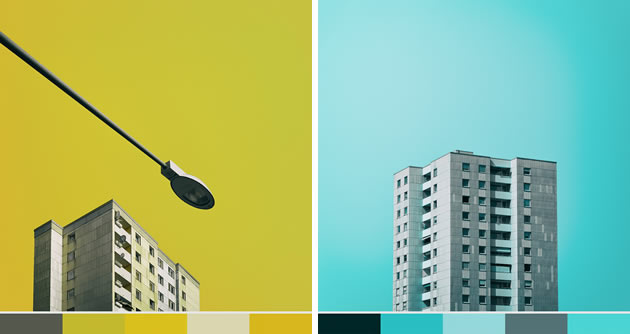

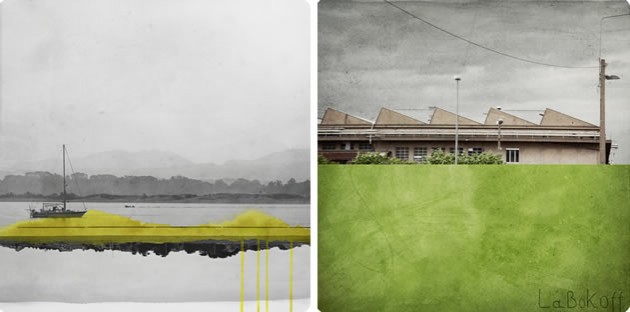
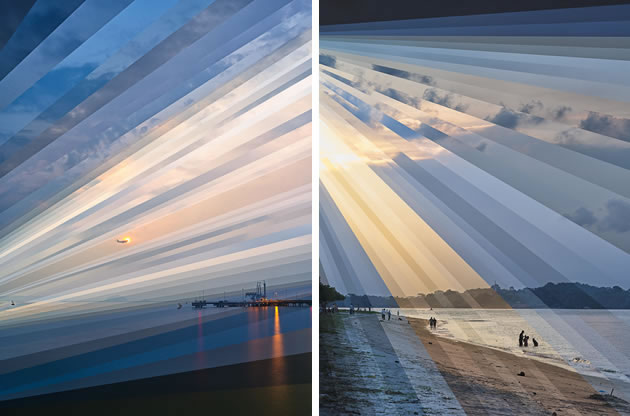
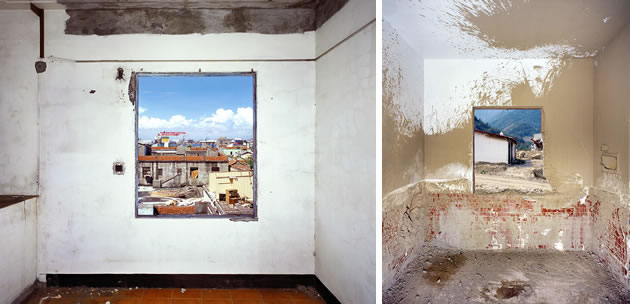
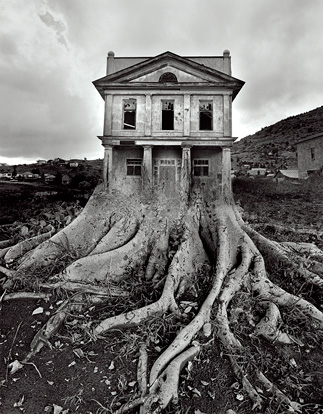
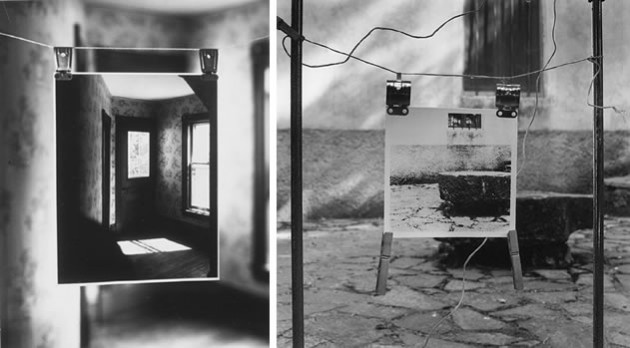
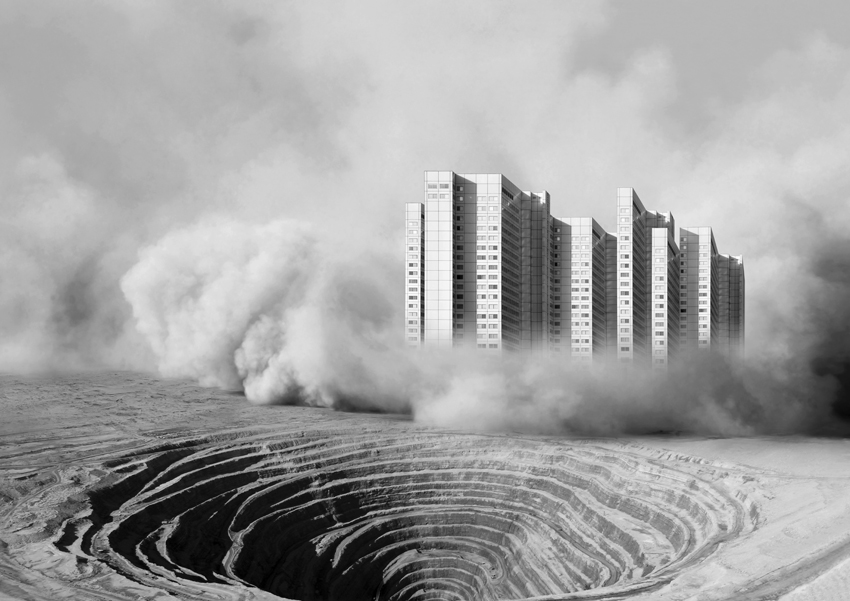
Presentation // grouping of images
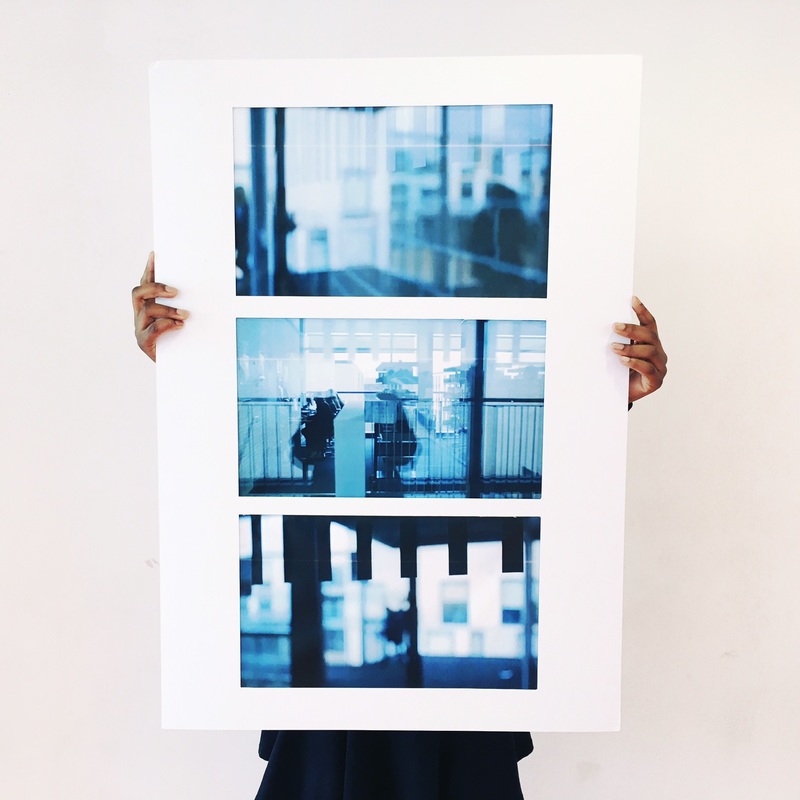
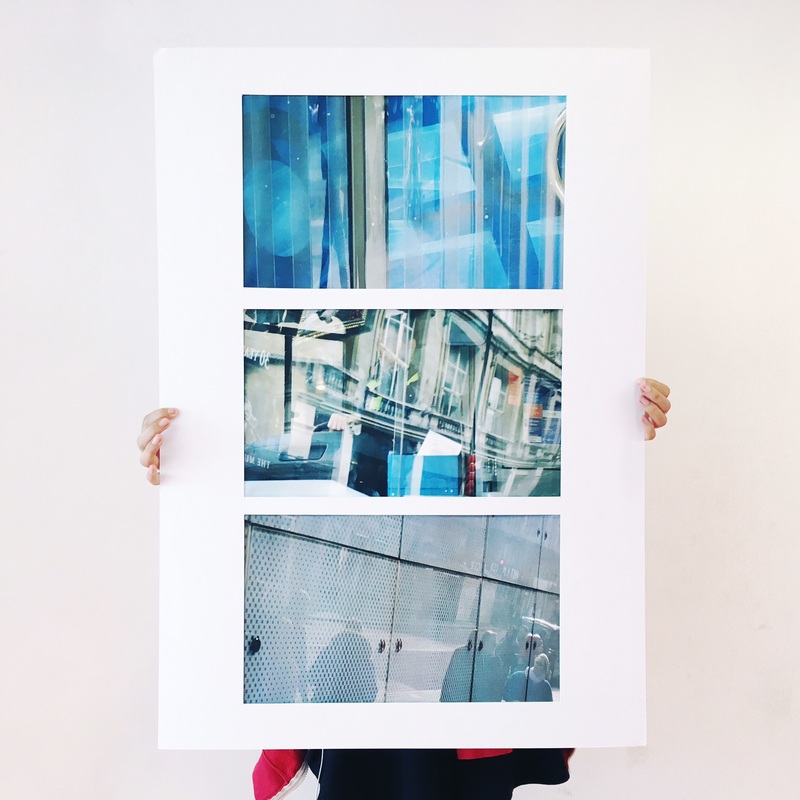
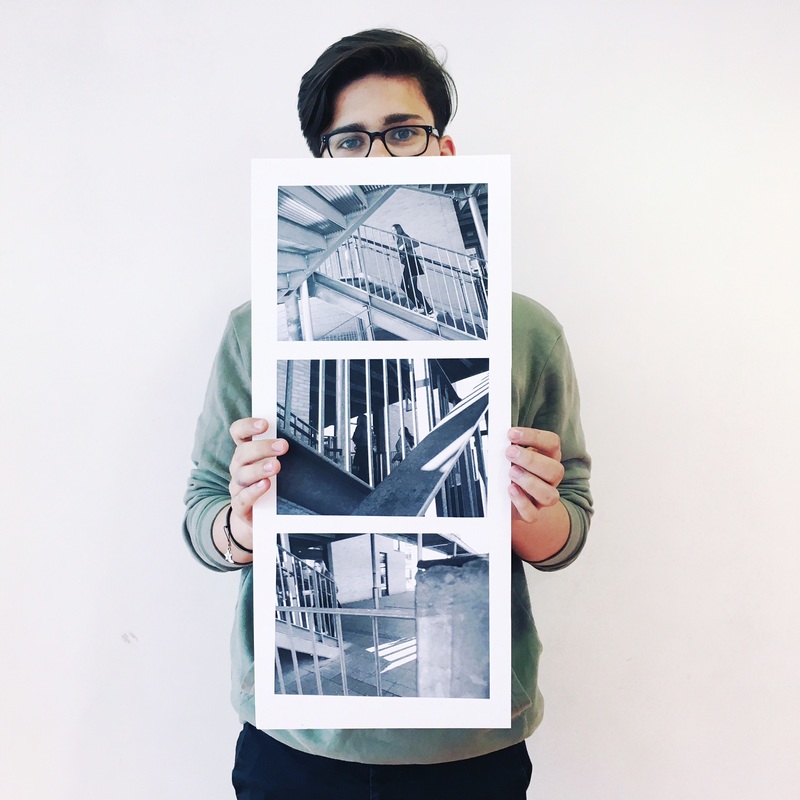
or you may want to include animation, time lapse film or other forms of image presentation like…
Koyaanisqatsi ( “life out of balance,” this renowned documentary reveals how humanity has grown apart from nature. Featuring extensive footage of natural landscapes and elemental forces, the film gives way to many scenes of modern civilization and technology.)
You can use this link to help with analysis…
http://www.photopedagogy.com/photo-literacy.html
Landscapes // Mock Exam – Initial Research
POWERPOINT NOT COMPLETE

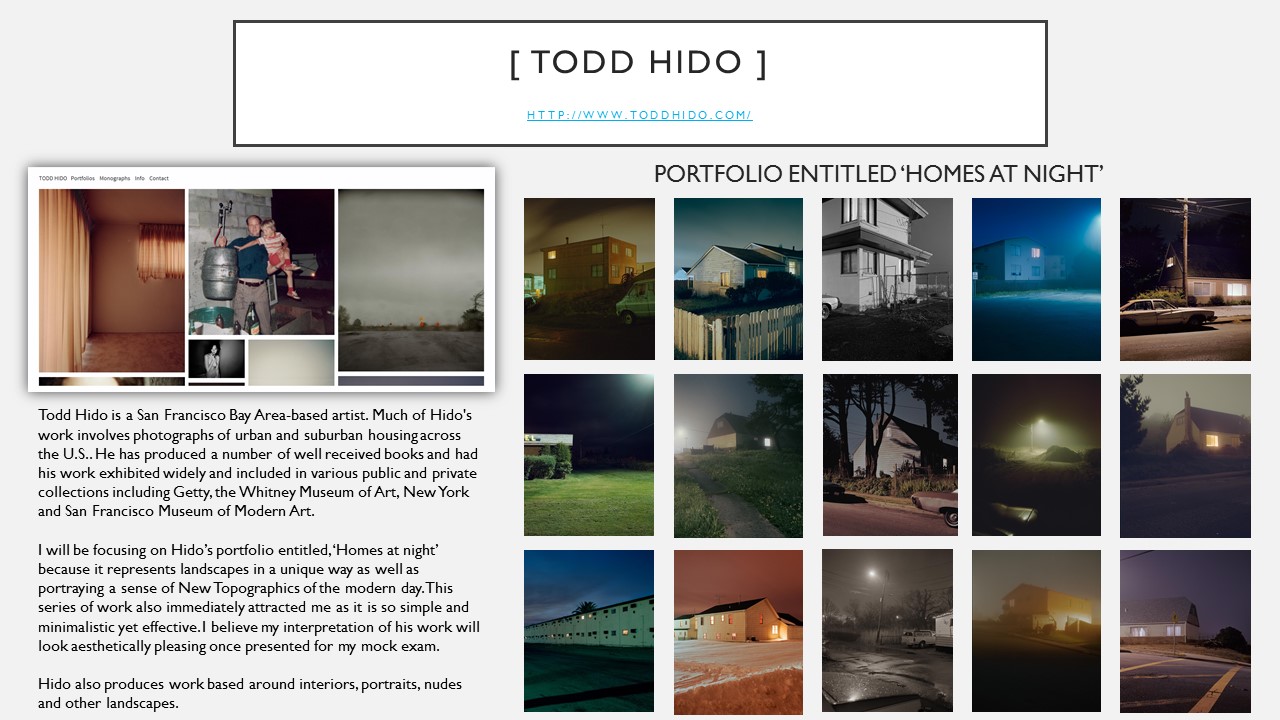

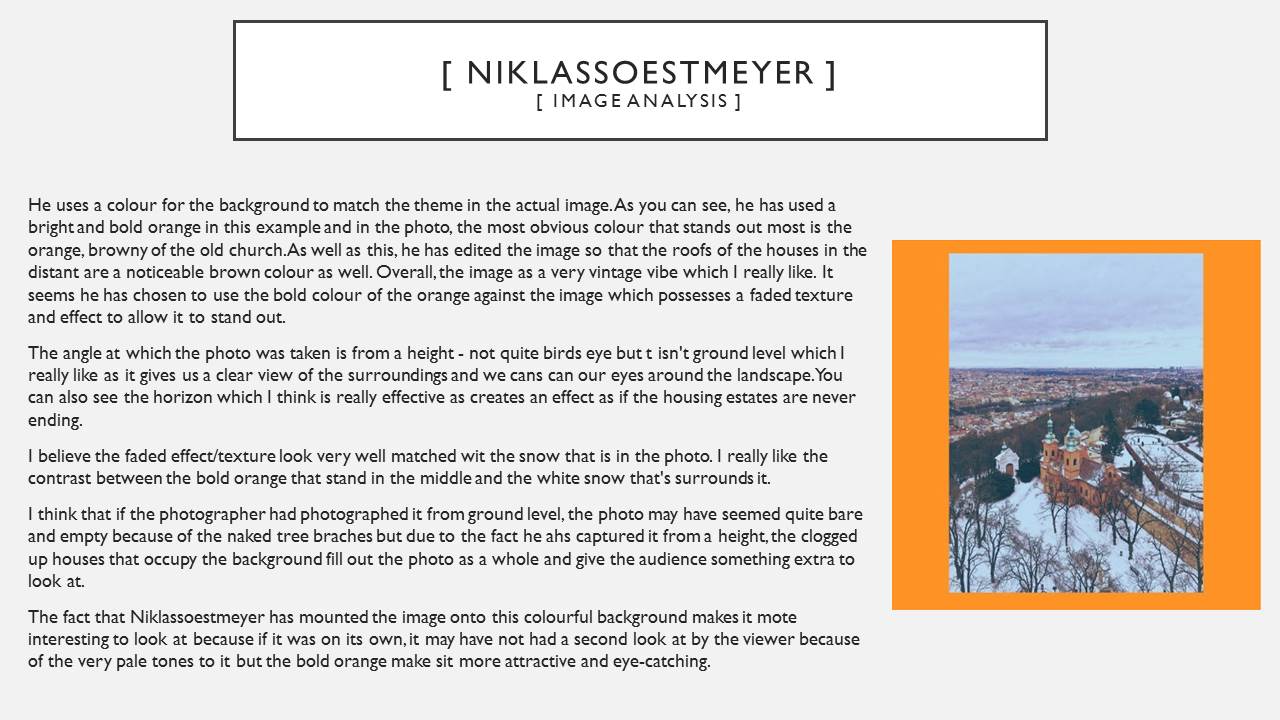
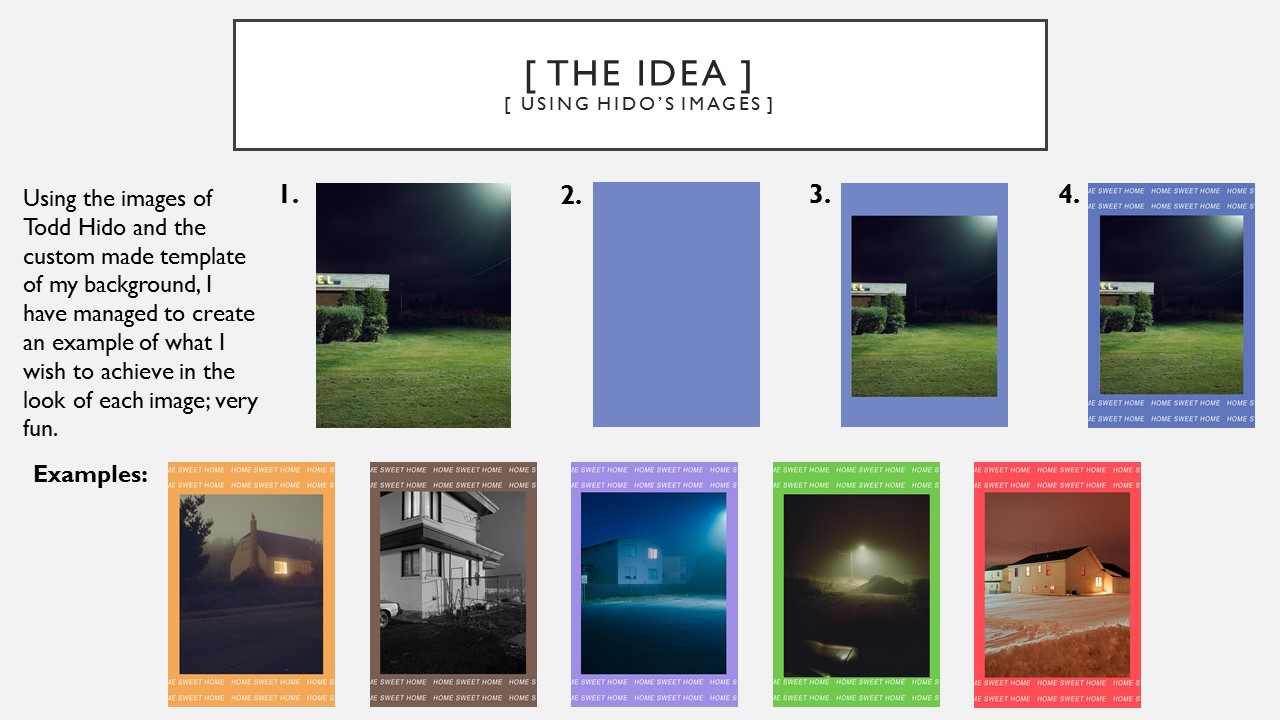


A Certain Walk – Jersey Art Centre Exhibition
On Thursday the 12th January I visited the Jersey Arts Centre. The Arts centre focuses on promoting and encourage the development of art. Their website says they aim to:
- “To enrich the quality of life for all residents and visitors
- To encourage participation in the performing, visual and literary arts
- To educate, inspire and to encourage debate”
The exhibition, known as: “Climate State of Emergency” in association with Alliance Francaise builds upon the theme of how climate change impacts different people in different parts of the world. The exhibition was responding to the 2015 United Nations Climate Change Conference in Paris.
The exhibition portrays the serious dangers of climate change exposing the level of truth despite endless politicians burying and therefore prolonging the issues that have already arisen. This exhibition successfully points out to us of ho climate change has got so bad that it cannot be an issue that is simply swept under the rug for another 50 years. In this sense it is somewhat a form of protest for the lack of things being done with the issue and how it harms everyone on an international level.


My favorite photographs:

What I like about these photographs:
- Tells impact of man’s actions
- Sad/distressing
- Lack of life – nervous
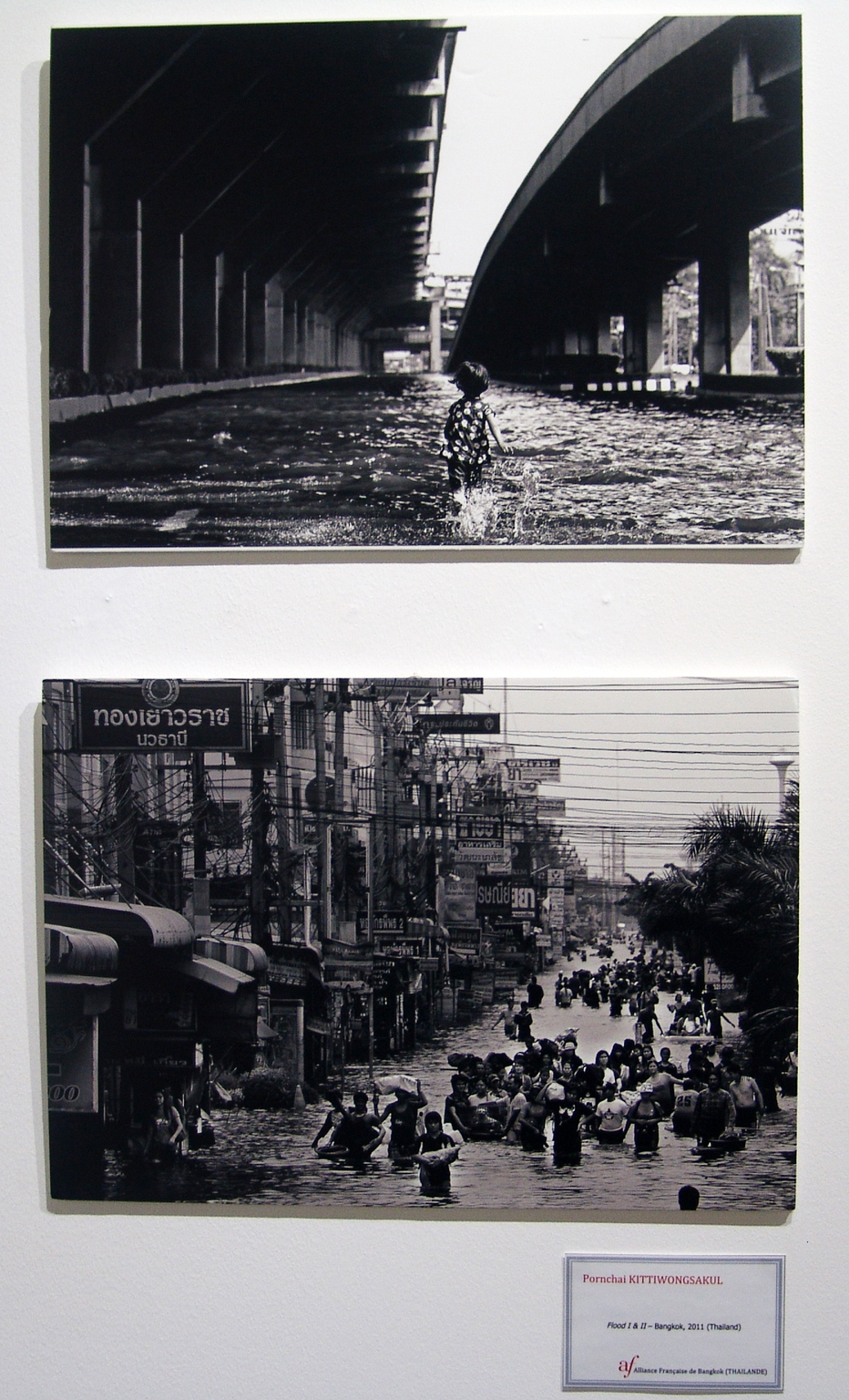
What I like about these photographs:
- Serious/crisis level, impacts us all
- Strong contrast
- An issue we cannot ignore
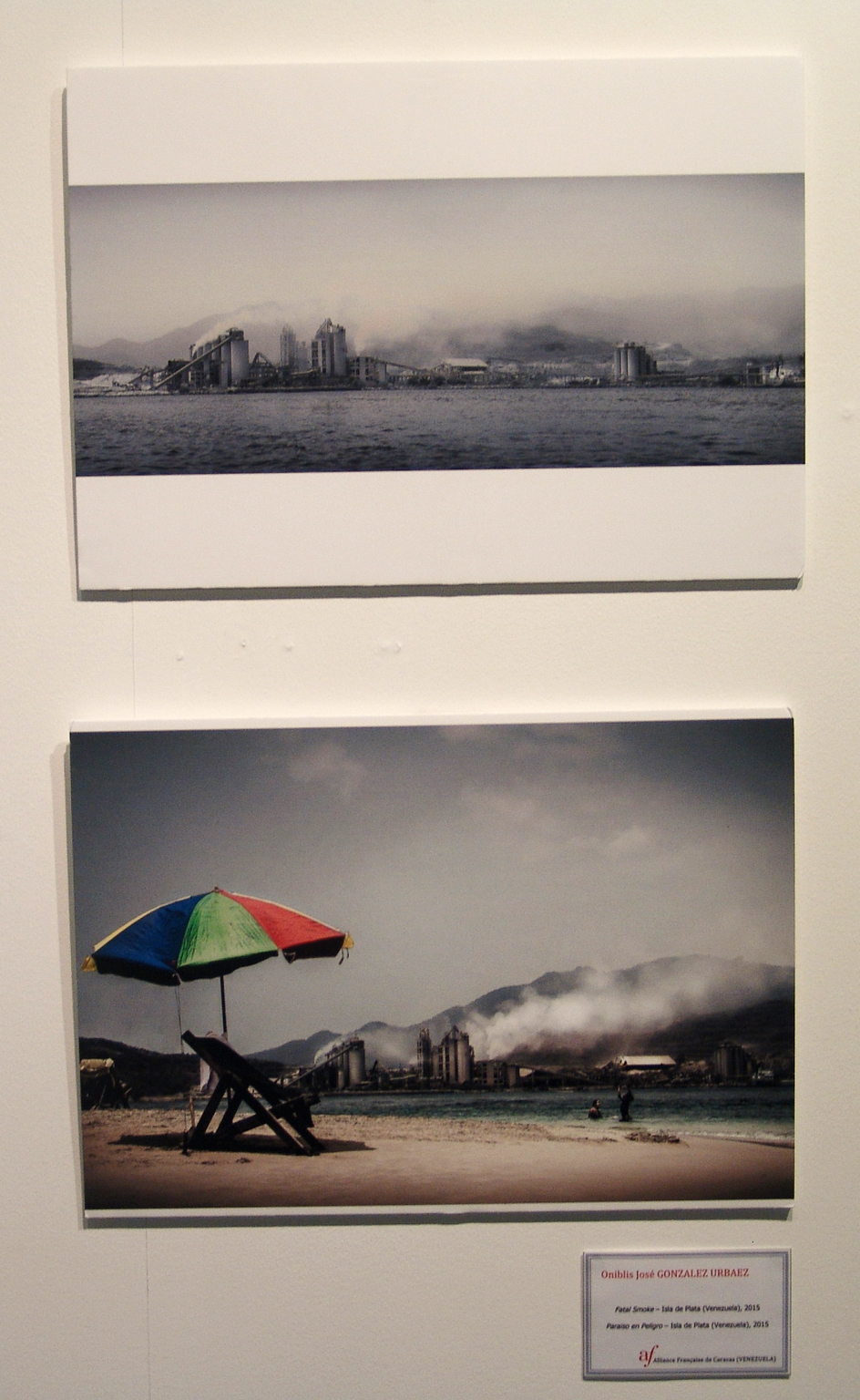
What I like about these photographs:
- World is suffering
- Little amount of colour stands out
- Tells a story
- Feeling of abandonment from a once happy place
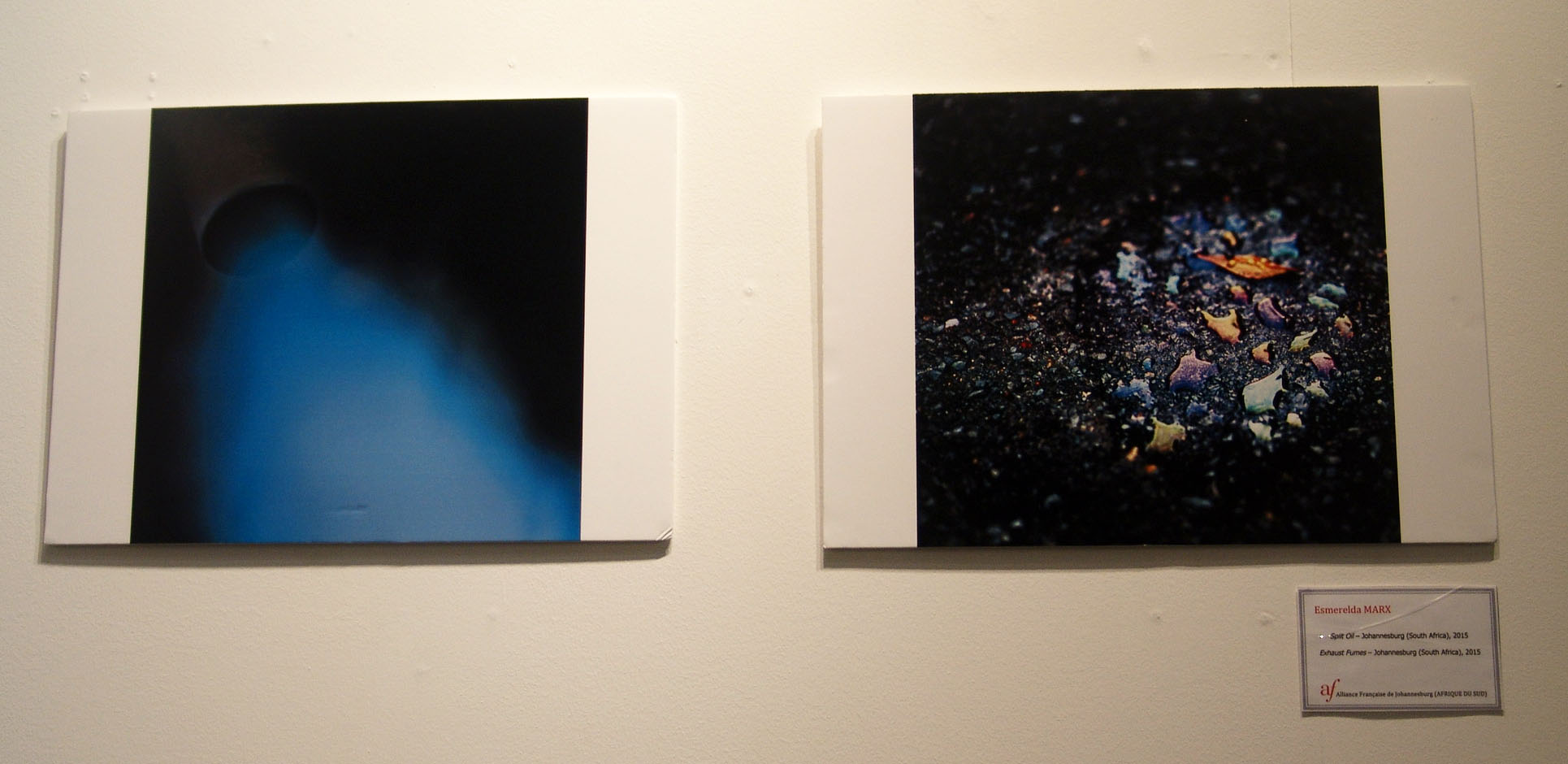
What I like about this photograph:
- Appears toxic
- Dark levels, appears dangerous to go near
- Quite dirty
- Colour projected
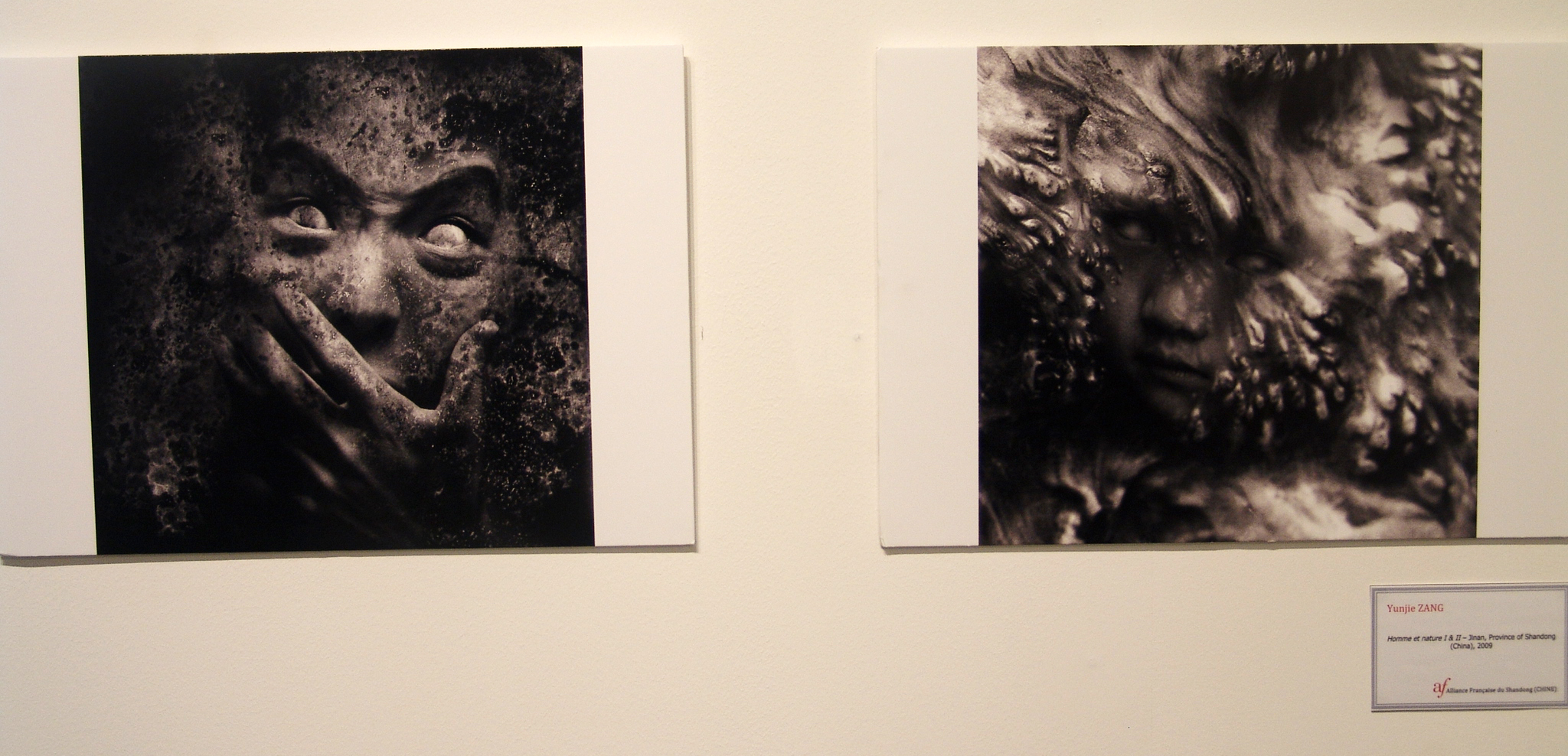
What I like about these photographs:
- Lots texture
- Taken on Macro to pick out detail
- Appears quite painful
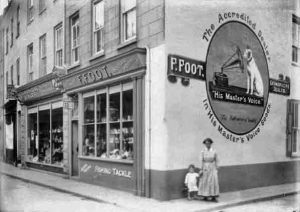
Using Photo Archives to explore Our Changing Landscapes
What Are Archives?
In the course of daily life, individuals and organizations create and keep information about their personal and business activities. Archivists identify and preserve these documents of lasting value.
These records — and the places they are kept — are called “archives.” Archival records take many forms, including correspondence, diaries, financial and legal documents, photographs, and moving image and sound recordings. All state governments as well as many local governments, schools, businesses, libraries, and historical societies, maintain archives.
Your task
The images above are Archival Images from iconic areas of Jersey…and these areas have changed over time.
- Find archival images that correspond to your own landscape photography and contrast and compare. Include any info you can find about the image itself / photographer / time period etc
- OR…you may find that you are intrigued by a particular landscape image and want to respond to it and create a comparison / composite image. For this you must conduct a photo-shoot aiming to document the area from a similar viewpoint and edit your images accordingly
- OR…you may want to explore the concept of JUXTAPOSING Old and new buildings / parts of Jersey…either by photographing them in situ, or creating a composite image using photoshop
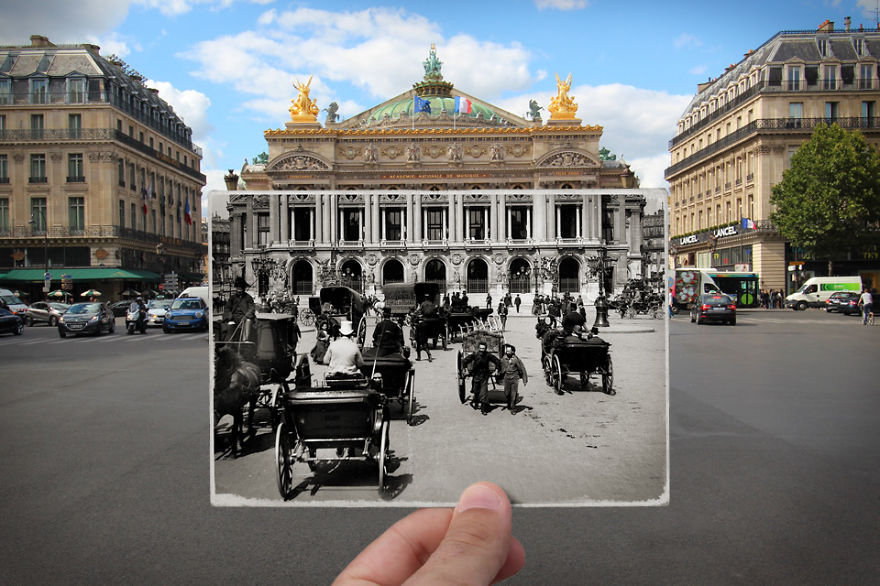
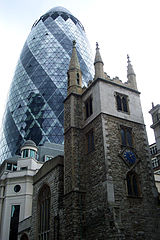
Public archives in Jersey
Jersey Archives: Since 1993 Jersey Archive has collected over 300,000 archival records and it is the island’s national repository holding archival material from public institutions as well as private businesses and individuals. To visit click here
Jersey Archive can offer guidance, information and documents that relate to all aspects of the Island’s History. It also holds the collections of the Channel Islands Family History Society.
Societe Jersiaise: Photographic archive of 80,000 images dating from the mid-1840s to the present day. 35,000 historical images in the Photographic Archive are searchable online here.
Societe Jersiaise also have an extensive library with access to may publications and records relating to the island’s history, identity and geography. Click here
Archisle: The Jersey Contemporary Photography Programme, hosted by the Société Jersiaise aims to promote contemporary photography through an ongoing programme of exhibitions, education and commissions.
The Archisle project connects photographic archives, contemporary practice and experiences of island cultures and geographies through the development of a space for creative discourse between Jersey and international practitioners.
introduction to identity and self-portraits
